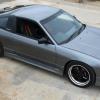Light weight flywheel = less torque?
Announcements
-
Similar Content
-
Latest Posts
-
It's definitely not firing order. But I think it should also be made clear that the output that gets fired is the one that corresponds to the input that was switched at the ECU. So you could scramble them up totally so that the numbers meant nothing, and so long as you had the inputs and outputs matched up, you'd be fine. The reason I make that point is that blanket statements about what it is supposed to be don't always hold out in a world where there's been 30 years for the wiring to have been stuffed with.
-
Hello, im asking about this guy - coil igniter on rb25det series 1 r33 s1 engine. I need to know if pins on coil side indicate coils itself from 1-6 or it’s firing order so pin nr1 goes to 1st fired spark plug:(1pin-1firing spark, 2pin-5order firing spark, 3-3, 4-6, 5-2, 6-4…) photo: https://files.fm/f/k9pdug38uq
-
Remove it. Certainly from the hub face. I'm not in love with leaving it on the wheel assembly surface either - but if it is common to do so, then....maybe fair enough. It's not difficult. Just time consuming. For the hub face you just need a large enough block and suitable grades of abrasive paper to get it off flat. The same would be true of the assembly face. Just more time consuming, probably needing a lot more care. It's defo going to be easier just to assemble the wheels as is, seal them up, and check them periodically to see if there's any movement or loosening of the fasteners, than it will be to remove it though.
-
Hello, I got my wheels powder coated and they've powder coated bloody everything the mating surface and hub (even told them not to lol) anyway should I leave it or remove it. (Would be very hard) I've searched a lot and lots of powder coaters don't mask the mating surface but do mask the hub surface. How bad it powder coat on the mating surface or hub? My question is what should I do?
-
Yeah, R34 with RB25DE likely has a 4AX01 box in it, which is a medium duty auto ~ with the RB25DET mill, it would've been fitted with 4AX00 (4AX13) heavy duty build (same case, different internals). An RB25DET will lunch on a medium duty 4R01 auto in pretty short order ...to give you some visual idea of differences between the 'medium' and 'heavy duty' boxes, you only have to look at the 2/4 band for comparison...it's chalk and cheese...(plus bigger high clutch, extra pinion in the planetary sets, higher oil pump output, different bearings, higher TC stall speed )... You can control them with just about any aftermarket TCU for electric-over 4-speed with TC lockup clutch (ie; the GM 4L60E and others)...I have a custom standalone TCU that includes MAP sensor (for turbo applications) along with TPS, RPM, and line pressure monitoring...in other words, I don't use any ECU signals...no real need to.
-







Recommended Posts
Create an account or sign in to comment
You need to be a member in order to leave a comment
Create an account
Sign up for a new account in our community. It's easy!
Register a new accountSign in
Already have an account? Sign in here.
Sign In Now